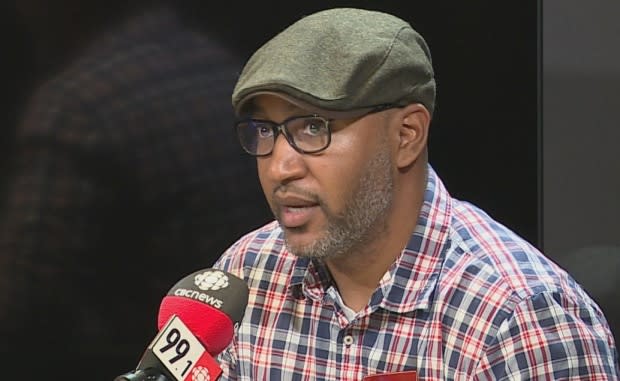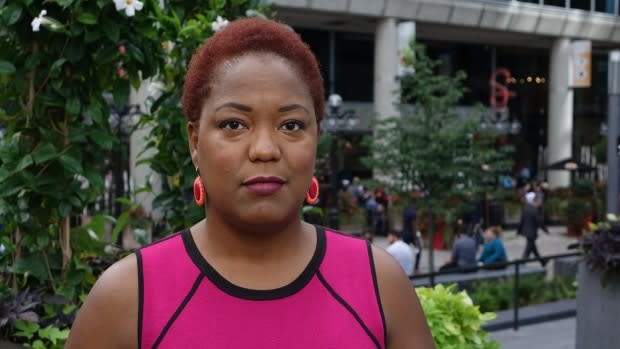Black with a capital 'B': Why it took news outlets so long to make a change that matters to so many
One after the other, a number of news organizations across Canada and the United States announced in June the same change in their language guidelines: to capitalize the word "Black" when referring to Black people and culture.
The Globe and Mail made its announcement on June 3, followed by the CBC on June 8 and The Canadian Press the next day.
In the U.S., a number of news organizations, including the Los Angeles Times, NBC, The Associated Press and the New York Times, also announced the same change to their style guides.
The announcements by so many news organizations coincided with the massive Black Lives Matter protests across the United States and Canada that have led to widespread reflection about the impact of racism across society, including in policing, the justice system, education, politics and the press.

Journalism style guides are, by nature, rigid and slow to change, purposefully upholding established rules and conventions. But many activists, academics and journalists of colour say the language used by the news media to describe diverse communities is particularly slow to catch up because there's a lack of diverse voices in news organizations responsible for making such decisions.
Slow change
In 1930, American activist W.E.B. Du Bois was successful in getting the New York Times to start writing the word "Negro" with a capital N.
He had been campaigning for the change since the 1920s. He called the use of a "small letter for the name of 12 million Americans and 200 million human beings a personal insult."
Many Black people have been writing Black with a capital "B" since the 1960s, inspired by the Black Power movement started by civil rights activist Stokely Carmichael.
There have been calls for publications to follow suit for the past two decades.
The police killing of George Floyd in Minneapolis in May reinvigorated the Black Lives Matter movement not only in the U.S. but in more than 60 countries worldwide, including here in Canada.

Newsrooms across North America are now taking a hard look at themselves, as journalists of colour, particularly Black journalists, point out the many ways in which news organizations have let them down.
And one of those ways has been through language.
Spelling "Black" with a capital "B" has been a common practice of publications that focus on the Black community, such as Essence and Ebony magazines, for example, for more than a decade. It is also offered as an option by Oxford and Merriam-Webster dictionaries.
Black writers and activists have long petitioned for the change in news copy.
James McCarten, stylebook editor at The Canadian Press, the authoritative guide for Canadian news writing and editing, said although the guide is the standard that news media follow, it does not set the course for changes in language.
"It does not chart the path; it follows the path that the users of the language are blazing," he said.
The Canadian Press prefers not to rush into making changes to its style guide, he said, "for the simple reason that constantly changing a style essentially means you don't have a style."
He said The Canadian Press had to wait and see if "Black" with a capital "B" was consistently used before revising its rule.
"When you make a change, you can't have to go back on it. You have to be sure that this is where the language is going to go, this is where the usage is going to go."
At the CBC, the style guide says the lowercased version was based on a longstanding convention of using lowercase letters for "racial, ethnic and nationality labels not directly rooted in proper nouns. (e.g., African, European and Latino, but 'black,' 'white' and 'brown')."
The rationale to make the change was to "respect frequently voiced preferences of Black people" and "reflect increasingly common usage in Canada," according to standards editor Blair Shewchuk.
The Globe and Mail gave a similar explanation in its public statement.
Lack of representation
Handel Wright, director of the University of British Columbia's Centre for Culture, Identity and Education in Vancouver, said it helps if newsrooms listen to communities on how they would like to be represented, but it is even more important that members of those communities are actually part of newsrooms.
"Part of what needs to happen is that the media need to be more representative of the group that they're speaking about. So ... who is reporting about different groups makes a difference," he said.
"I think it is reflective of the fact that maybe the media itself is not diverse enough that the media is always playing the catch-up game."
The 2016 Canadian census found nearly a quarter of citizens identified as Black, Indigenous or a person of colour (BIPOC).
CBC/Radio-Canada tracks the diversity of its workforce with a voluntary survey. As of 2019, visible minorities made up 16.5 per cent of the workforce in English services and 6.5 per cent of the workforce in French services. Indigenous staff accounted for 3.6 per cent and 1.1 per cent, respectively. Among CBC/Radio-Canada executives, 4.1 per cent were visible minorities, and none were Indigenous.
The Globe and Mail did a voluntary survey in 2018 in which 60 per cent of staff participated. The results showed that 23 per cent of staff identified as visible minorities.
Maclean's and the Toronto Star both changed their style to "Black" with a capital "B" before other Canadian outlets after columnists of colour in their newsrooms called for the change.
When Maclean's did so in 2015, it was because of contributing editor Andray Domise.

Although glad to see the change, Domise nonetheless questions why it took Maclean's so long to make it.
"Why wasn't it a standard before I got there?" he said.
As for the outlets who made the same change last month, he questions the motives behind it.
"Why not before? What changed? What was the difference between then and now?" he said.
"Personally, I don't think anything has changed except that we are seeing an uprising happening. To me, it's almost an esthetic means of placating the masses, rather than engaging in substance of change."
Anthony Collins, style chief for the Toronto Star, said the newspaper changed its spelling of "Black" in 2017 because Shree Paradkar, the paper's race and gender columnist, explained why it was necessary.
He acknowledged that a lack of newsroom diversity helps explain why outlets are slow to respond to language changes that communities want to see in the media.
"I think there's often a lot of uncertainty about what term to use and a lot of nervousness around using the wrong term, which, frankly, I think just comes from having a newsroom that's not as diverse as it should be," he said.
"I think the Star, you know, has a broad readership, and we serve a very diverse community. And I think if a community doesn't see itself reflected in our stories, or is misrepresented somehow, I think that's incredibly injurious to public trust in our journalism."
Describing communities appropriately
Despite the change to the word "Black" and other style guide adjustments, journalists of colour and activists agree that news organizations and journalists still have a long way to go when it comes to using the appropriate language to describe Indigenous and Black people and people of colour.
Another relatively recent language change at news organizations such as CBC and The Canadian Press includes encouraging journalists to specify, if possible, what Indigenous nation a person belongs to instead of just referring to them generically as Indigenous.

But Rachel Decoste, a community activist in Ottawa who had been advocating for the CBC to change its guideline on the word "Black" for years, says more changes are needed.
She also wants newsrooms to use the term "enslaved Africans" instead of "slaves" when discussing slavery. The change started in academic circles as a way to describe enslaved individuals as people first, commodities second.
"Now that we are writing 'Black' with a capital 'B,' perhaps our ancestors could also get the respect that they deserve," Decoste said.
Beyond style guides
And although style and language guides might change, there are many other factors that go into telling a story.
For example, some of the early coverage of the Black Lives Matter protests in American and Canadian media was criticized for mirroring the language used in reporting on the civil rights movement in the 1950s and '60s, particularly in the way violence was often attributed to protesters rather than police.
Domise said some of the reporting following the killing of Floyd was quick to describe the protests as "violent" as soon as property damage was involved.
"No, the violence was already pre-existing," he said of this type of coverage.
"The violence was what precipitated the protest in the first place. A police officer suffocated somebody to death in the middle of the street. You can see the anti-Blackness seeping out of the narrative.
"I was alive in the early 2000s, in the 1990s and 1980s, and nothing has changed in terms of the way the media writes about Black people. So, how far have we come along? We haven't."


